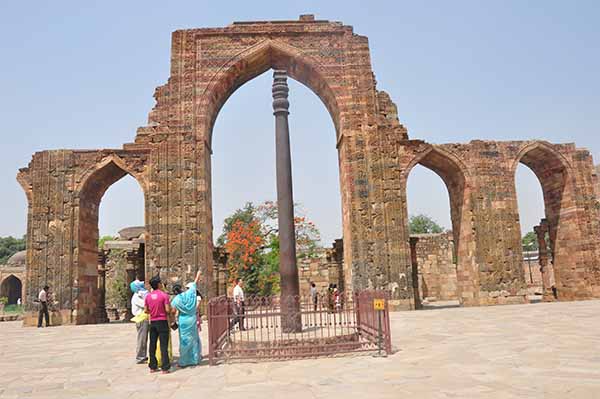Interesting Facts About Iron Pillar of Delhi

The iron pillar of Delhi is undoubtedly one of the most popular vestiges of the 20th century. The legend says that it ensures the happiness of all those who manage to put their arms around and to join their fingers. It is also claimed that, since its erection several thousand years ago, this pillar has braved the weather and yet, even today, it bears no trace of rust.
Description...
The Qutab Minar complex owes its name to a 73-meter Victory Tower, erected in Delhi in 1193. It houses the most important mosque in India: Quwwat ul-Islam Mashid, which means “Mosque of the power of Islam”. If the mosque and the Victory tower were built around the same time, another iron pillar, 7 meters high and located in the interior courtyard of the mosque, is much earlier than the construction of the complex. Above, a Sanskrit inscription indicates that the pillar once stood in another place.
In 1969, the Swiss explorer Erich von Däniken published, in one of his works, an article devoted to the iron pillar of Delhi. According to him, it would be composed of several welded pieces. In addition, the alloy used was unknown in Europe at that time and did not include phosphorus or soda, which is why, 4,000 years later, this pillar still does not show any trace of rust.
... and reality
A few years later, however, Erich von Däniken admitted very honestly that he had made a mistake. His first description, however, seems so convincing that many continue to give it credit. In fact, the iron pillar of Delhi is undoubtedly of great interest to scientists. But let's go back to the two mistakes made by von Däniken.
To begin with, this pillar most probably dates from the 5th century AD. It is believed to have originally stood near the Indian temple of Bihar, dedicated to the Vishnu deity. The unusual shape of its tip suggests that it was surmounted by a small statue or figurine. On the other hand, it does not consist of several welded parts and does not consist of unknown alloys.
However, it nevertheless has some unusual properties. Indeed, the pillar was probably forged in one piece, which, for a height of 7 meters, represents a weight of about 6 tonnes. Furthermore, the material used is an extremely pure iron (99.75%), which explains why, despite the hot and humid climate that prevails in India during the monsoons, the column has never rusted.
By way of comparison, you should know that in Europe, this kind of work was only possible at the end of the 19th century, that is to say some 1,500 years later. Previously, in fact, Europeans did not have the knowledge necessary to manufacture a column of this type. From the chemical point of view, the realization of this column is also amazing. In 1938, in fact, we managed to obtain an iron of such purity in the laboratory. However, under normal production conditions, it was impossible to obtain the same degree of purity on the finished product.
No one has yet succeeded in explaining how the blacksmiths of Delhi were able to obtain such a pure iron, without the metal losing its qualities.









































































































































































































































































































































